SPECIAL NOTE:Agility is a great sport and theres fun to be had by all. However, it is a sport and as in all sports if it is not approached correctly it can result in injuries to both the dog and handler. Most trials don't allow dogs to compete until they are 12 to 18mths old. This gives the dogs bones time to finish developing. In most cases instructors don't allow dogs in thier classes until 10 months of age. King was an exception because of his oversized stature and his need to gain confidience. I had a very knowledgable and cautsious instructor that allowed King in the class as long as We followed very strict guidlines for his health and well being. at 8 mths he was 16 inches and jumping 8. He was not allowed on the a-frame until 9 mths. now 17inches and oversized for conformation. However, when the small A-frame was removed from class and everyone began training on the larger one King was not allowed to climb it.That was a job in itself. The a-frame and the teater totter were and still are Kings favorite obstacles.
|
Dog Walk
You are viewing the standard dog walk, but in most cases beginners are started out on a much smaller one. You can make a back yard dog walk by putting a piece of plywood end to end across two chairs, blocks of wood or what ever as long as the board is stabilized. I used an railroad tie we had in our yard. For very young puppies you can lay the board on the ground completly flat and let them walk over it as often as they want. This will get them used to the sights and sounds of agility without being a safety hazard.
|
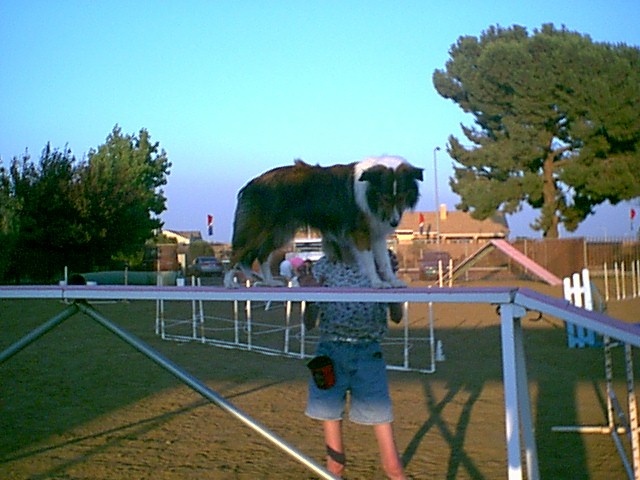 |
Teeter Totter
For Some dogs the teeter totter Can be a very scary experiance. For small and light weight dogs the fear stems from walking up the teeter and then not being able to get it to drop down and when it does dealing with the noise. For larger dogs it's the large bang and fast drop. Once King mastered the A- frame the teeter was a piece of cake. You can make a back yard teeter by taking that same piece of wood that you used for the dog walk and laying it over a barrel so the dog can walk across it and get the idea of motion under his feet. You need to help the dog or it needs to be stable enough that it will move, but it won't fall off the barrels. Young puppies can be introduced to the motion of the teeter by taking a tennis or similar ball and putting it under a small piece of wood and letting it walk on it. I use an old swivel style t. v. stand that is about 12 inches by 6 inches and 4 inches high. Of course you must make sure what ever you use is strong enough for the size and weight of your puppy.
|
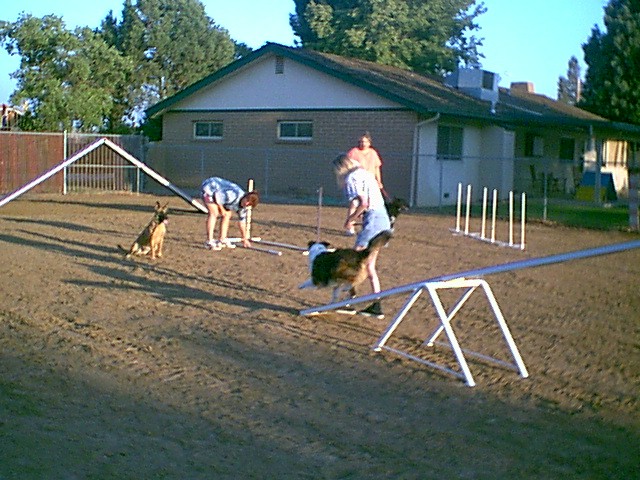 |
A-FRAME
King is on the a-frame in the back of this picture, but you will also see several varieties of weave poles, an open tunnel,the dog walk and the teeter totter. When teaching the A-frame it is very important that you don't rush the dog over it before he is ready. You should never let a puppy on any A-frame before it is 8 months old and then only on a very little one. A standard A-frame should be left to dogs of one year and older. You can start familerizing young puppies with the A-frame by making a small picture frame style structure measureing about 8 to 24 inches tall depending on the size and weight of your puppy.
|
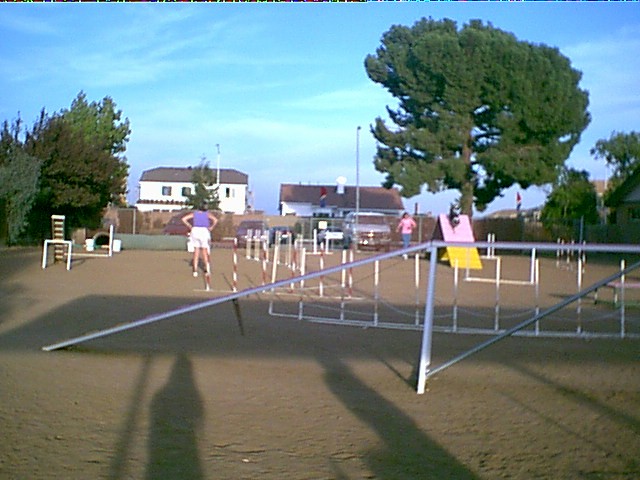 |
BAR JUMP AND OPEN TUNNEL
In this practice excercise King Jumped over the bar jump, went through the open tunnel and then returned to my side. In agility you will also see a closed tunnel which is a tunnel with a shorter barrel that has a chute attached to it and the dogs must run through it and on to the next obstacle without getting tangled inside or disorientated, which does happen to some beginning dogs. Puppies can be introduced to the tunnel at any age. However I wouldn't advise the closed tunnel until at least three months and with supervision, because you would not want to risk spooking them into never wanting to go into the tunnel again. You can however get them used to not being able to see and being wraped up by playing games with them using a blanket or a towel. Puppies under 6 months old should not be encouraged to jump due to the risk of muscle and tissue damage. If they are natural jumpers and do it on thier own praise them for it and that will be encouragement enough. You can also put boards on the ground and say jump they will learn the term and not get injured.
|
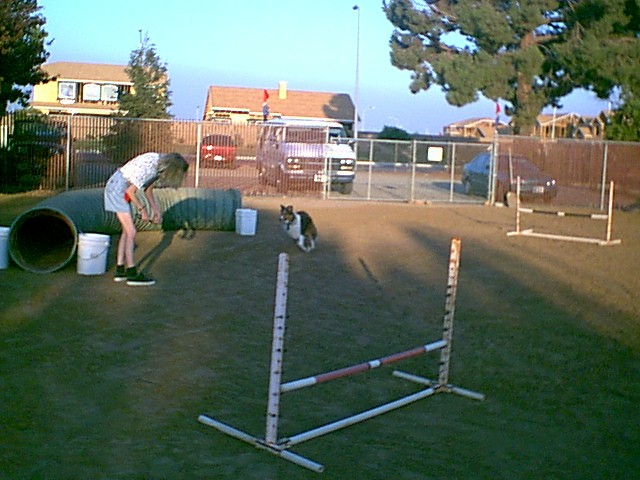 |
WEAVE POLES
In training there are several different ways to teach the weave poles. Most trainers use the double poles with wires makeing a chute for the dogs to run through as shown in this picture. The poles are gradually moved closer together until the dog has no choice but to weave through the poles. Although if the wires arn't put at the right level for the dog some dogs will jump over or go under the wires at first. Some trainers train without wires, others use criss cross or offsided poles.
|
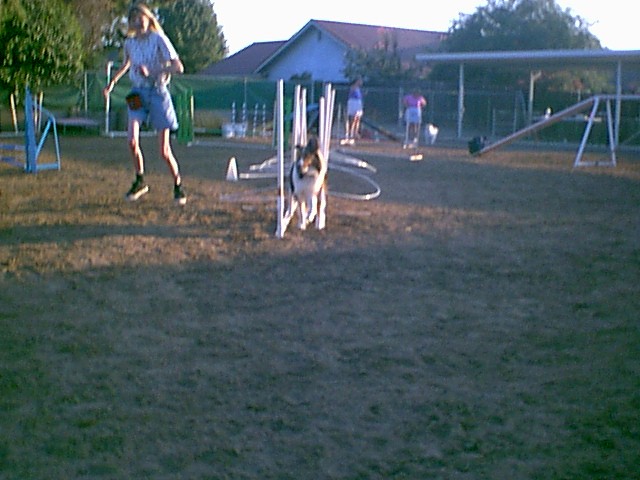 |
|
KING WATCHES AND WAITS FOR HIS NEXT COMMAND
The dog that stays focused on his owner is a dog that completly respects and is commited to his owner. I believe this is the greates sign of respect a dog can show his/her owner and the number one way to bring home the title. Especially if you must lead out away from your dog or use lots of send outs as in my case. If the dog remains focused on you he won't miss the signals you are sending him/her.
|
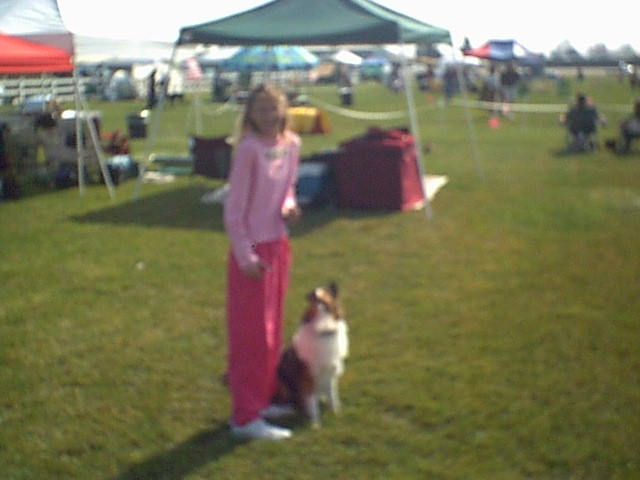 |
|
KING AND KATIE PRACTICE BETWEEN RUNS
Warm ups before shows are great, but you must also rember not to tire your dogs out to much before they must perform. It is important that your dog has plenty of water and a chance to get centered and focused on you before you just rush him/her out onto the field. If you are running lots of dogs close together try to remeber they are not yo yo's and they need a warning call and a moment to get focused just like we do.
|
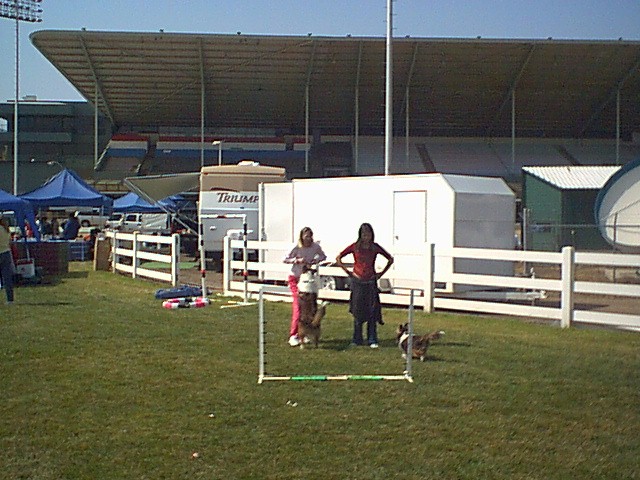 |
|
SEND OUTS
Send outs are great especially if your dog is a lot faster than you or if you want to play the Gamble. ( a Game offered at some trials) To teach the send out set up a table and a couple of jumps put a target on the table with a treat. Say table and have your dog go jump on the table and get the treat. Then get back behind one jump do it again and so on and so fourth. You can do this for any equipment.
|
|
|
CONTACTS
Contacts are very imoprtant and the worst thing you could ever do is stop practicing them. Even the best dogs will get sloppy on them if they are never reminded how important they are. Puppies can start learning these very young, but they should not go over the a-frame until 1 year old. Unless it's a minature a-frame and then they should be at least 8 months and on the advise of a trainer.
|
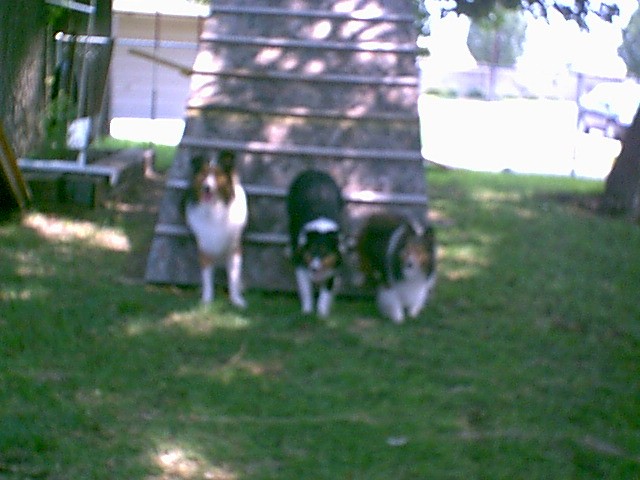 |
|
IF YOUR HAPPY AND YOU KNOW IT FLAP YOUR EARS
King is happiest when he's in the agility yard or with his agility buddies. SPEACIAL NOTE: I want to make it clear that I am new to agility and the information I have given you comes from my instructors, books I have read and my own experiances over the past year. I am by no means a professional at the sport, but I wanted to give other beginners the opportunity to see what agility is all about from a newcommers point of view. I also wanted to let those with handicaps know that there is a way to get past the running and train your dog to perform with ques alone and no runing at all. Right now I am using lead and send outs and that is working pretty well, but the problem is I still have to run part of the course and I get very tired which causes me to lose focus and get lost on the field and in turn costs us the run. My goal is to be able to lead out to the center of the field and use only my voice and hand signals to guide King. In the end I want my only purpose in the ring to be to take King off the leash, use my voice or hand signals to send him to the obsticles and then put him back on the leash when he's done. By accomplishing this King will not only be able to continue to be apart of the sport he loves so much, he will also have a better chance of excelling at it.Not to mention if I can master this I can help other people with handicaps do the same.
|
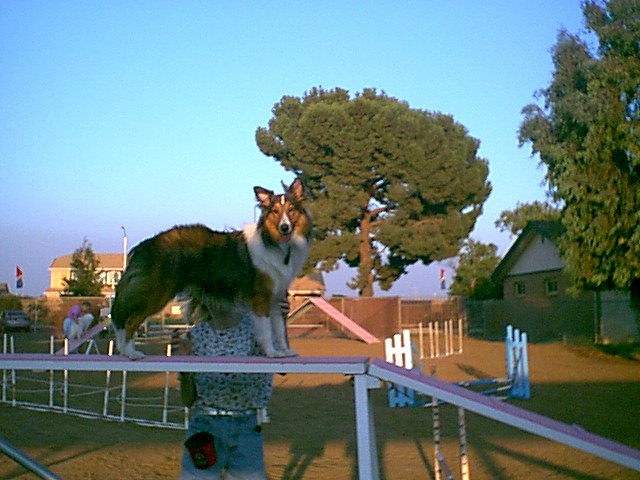 |